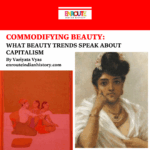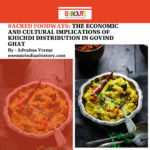The Blossoming Devotion: An Exploration Of Hinduism’s Beloved Divine Flowers
- EIH User
- March 20, 2024
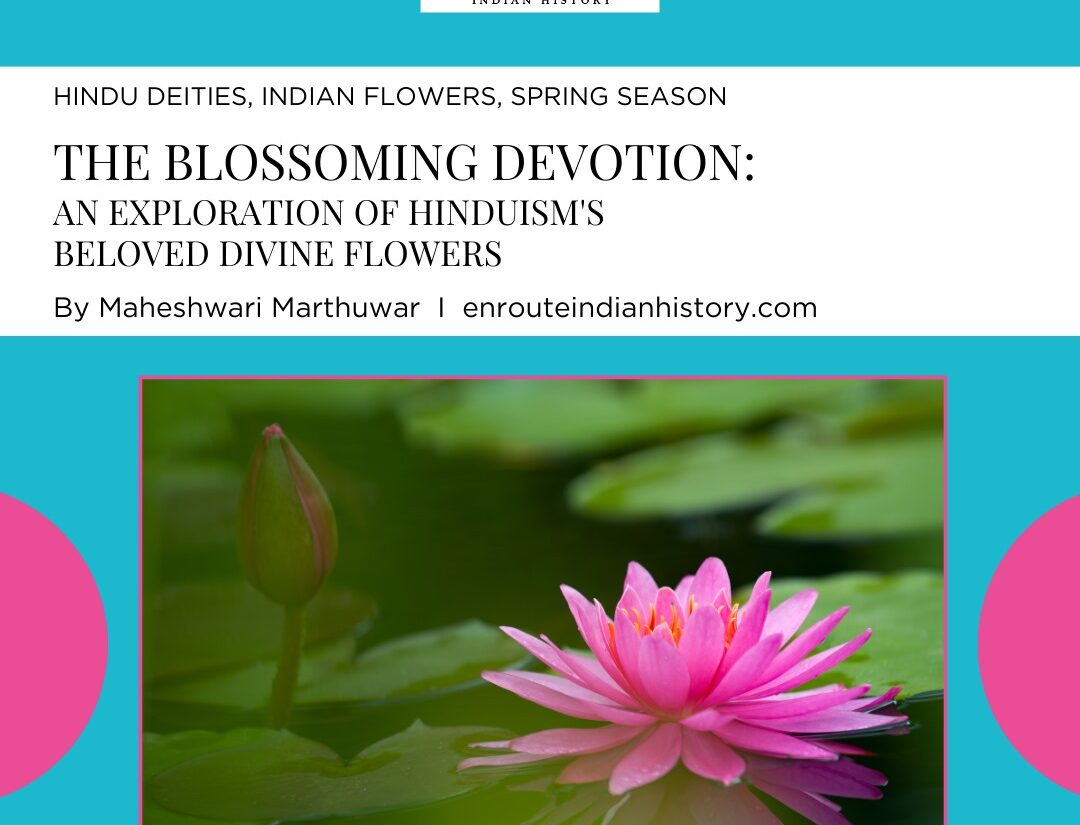
Flowers possess a remarkable ability to bridge the gaps between diverse cultures, religions, and political beliefs. While they are cherished for their aesthetic appeal and ecological significance, their symbolic meaning in various cultural and religious contexts is equally profound. Flowers are universally intertwined with positive religious and spiritual beliefs, representing God’s creation or embodying spiritual practices. They serve as powerful symbols of shared values such as love, virtue, respect, and hope, and are often used as metaphors for fundamental human aspirations like fertility and prosperity. Many religions incorporate Flowers into their art and architecture, both for their symbolic significance and decorative purposes, and some even offer them as tangible offerings to deities during worship ceremonies. Flowers play a significant role in Hindu Pajas, as a ritual is considered incomplete without the offering of Flowers to deities. It is crucial to understand the appropriate Flowers to offer to each God in order to maximise the benefits of the Hindu Rituals. In addition to Darshan, Puja is another important aspect of Hindu Worship. During this offering ritual, worshippers engage all five senses. With the help of a priest, they present Flowers , Food, and Pour Water and Milk over the image, seeking its blessings. Chanting Mantras and Ringing Bells are also part of the Puja ceremony. Through these practices, Hindus express their Devotion and seek a deeper connection with the Divine.
In Hinduism, Flowers hold great significance and are an integral part of the primary prayer ritual known as Puja. This act of worship is often referred to as “the Flower act” in English. Among the various Flowers used, the lotus Flower holds special importance as it is associated with divinity, piety, beauty, and fertility. The Bhagavad Gita, a Hinduscripture, emphasises the importance of purity and detachment, drawing a parallel between these qualities and the Lotus Flower. Additionally, specific Flowers are linked to particular Gods or rituals, and Jasmine Garlands are commonly used in encouraging followers to embody these qualities.
Reason for why do people offer lotus Flowers to Buddha statues?
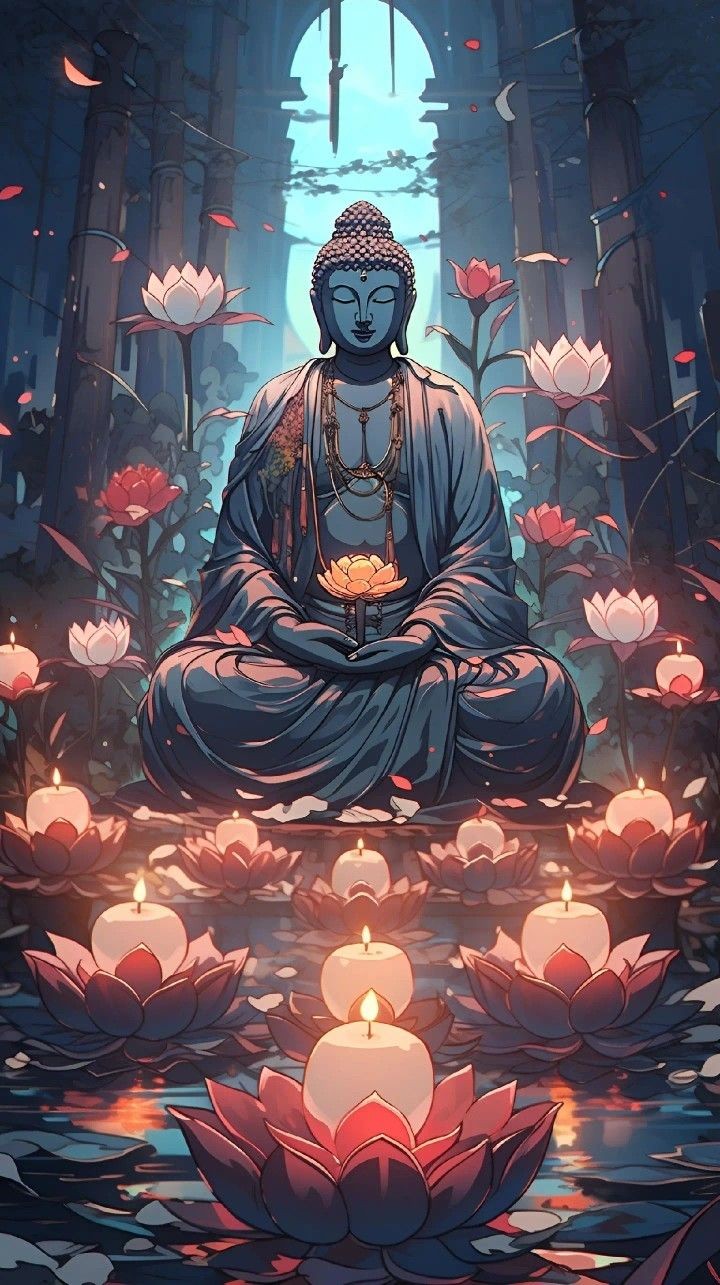
Similarly, In Buddhism, the lotus Flower holds a central position and symbolizes the highest level of spiritual enlightenment attainable by humans. It serves as a metaphor for knowledge and enlightenment and is frequently depicted in Buddhist artwork, often with Buddha seated on an open lotus Flower. Within the spiritual practice of Yoga, a significant branch called Hatha Yoga focuses on achieving the highest level of consciousness. Devotees striving for this state adopt a specific posture known as the lotus position, or padmasana in Sanskrit. Overall, the lotus Flower holds deep spiritual significance in both Hinduism and Buddhism. It represents purity, enlightenment, and the ultimate spiritual elevation that individuals can aspire to attain.
Puja, a ceremonial worship in Hinduism, encompasses a wide range of rituals, from simple daily rites at home to elaborate temple ceremonies. The term “Puja” is derived from the Dravidian word “pu,” meaning “Flower.” Typically, Puja involves offering Flowers or fruits to an image of a deity. The specific components of a Puja can vary depending on factors such as the sect, community, region, time of day, worshipper’s needs, and religious texts followed. Generally, during a Puja, the deity, represented by an image, is treated with the same respect as a royal guest. The attentions (upacharas) given to the deity begin in the morning, with gentle awakening, and continue throughout the day, including ritual bathing, dressing, serving meals, and finally, putting the deity to rest at night. Additional elements of a Puja may include circumambulation (pradakshina) of the image or shrine, sacrificial (bali) offerings, oblations to sacred fire (homa), and special ceremonies according to the festival calendar. One significant type of Puja is Arati, which involves waving lighted lamps before the deity or a person being honoured. This ritual is performed by circling the lamp in a clockwise direction while reciting prayers or singing hymns. Arati is commonly observed in Indian households for honoured guests and is also a part of various domestic ceremonies. Some Pajas can be performed by individuals, while others may require the assistance of a qualified Priest. Pajas can be conducted for specific purposes or as acts of Devotion.
Reason why Flowers are offered to God
Flowers have long been regarded as symbols of peace and are offered to Gods during worship in Hinduism. This act, known as ‘Pushpanjali’, is mentioned in ancient Hinduscriptures and involves chanting mantras while offering Flowers . The significance of Flowers in Hindu’Puja’ is multifaceted. Some believe that by offering Flowers , the deity bestows good health, wealth, and prosperity. Additionally, Flowers are used to create a welcoming atmosphere in places of worship due to their pleasant fragrance and aesthetic appeal. The act of offering Flowers is part of a ritualistic worship called ‘Puja’, where ‘Pu’ represents Flowers and ‘Ja’ represents chanting the holy names of Gods. Water, represented by ‘Jalam’, is also sipped during the worship. It is important to offer Flowers that have a pleasant fragrance and are cultivated on good soil, while wild Flowers and those with thorns should be avoided. When offering Flowers , devotees transmit their devotional emotions and request the almighty for health, wealth, and happiness.
Importance of Flowers in Puja ritual
- The concept of deities being drawn to specific Flowers is referred to as frequencies, and when these frequencies are released back into the atmosphere, they are known as ‘pavitraks’.
- Frequencies represent a subtle and less tangible form of the deity principle, while pavitraks are considered as a more manifest and subtle form of the same deity principle.

Let us now see the subtle drawing of a Hibiscus Flower
The Red Hibiscus Flower possesses the Ganesh principle, which is drawn towards its central space and released in circular patterns. This principle is absorbed by the Flower’s stem and then emitted into the atmosphere through its petals. Additionally, the stamen of the Flower absorbs the Ganesh principle from the surrounding atmosphere and emits particles that contribute vital energy or pranshakti. It is important to note that the Hibiscus Flower is of raja-sattva nature, resulting in the emission of Divine energy (shakti) and Divine consciousness (chaitanya) from its petals.
The viewers were able to understand the attraction of deity frequencies towards Flowers and how these frequencies are emitted into the atmosphere through different parts of the Flower, thanks to the subtle drawing. This emission of deity principles and pavitraks is a spiritual process that results in various effects, including the reduction of the raja-tama principle in the atmosphere.
The presence of negative energies in the atmosphere causes distress, but the deity principle projected by Sattvik Flowers can counteract this. The black energy, which is dominant in negative energies, is either reduced or destroyed by the Sattvik Flowers . Essentially, the Sattvik Flowers emit frequencies of deity principles that fight against the negative energies in the atmosphere. When these Flowers come into contact with a person who is suffering from the effects of negative energy, the negative energy subsides. It is important to understand the difference between negative energy and black energy. Negative energies are subtle and troubling energies in the atmosphere, while the energy of deities is characterized by Divine consciousness, bliss, and peace. Deities are predominantly sattva, while negative energies are predominantly tama. Negative energies harm us, while deities look after our welfare. When a person is severely affected by negative energy, their control over their mind, body, and intellect is reduced, and the control of negative energy is increased. This can affect the person’s thoughts and emotions. When an affected person encounters an atmosphere that is predominantly sattva, there is friction between the positive sattva atmosphere and the negative energy. This friction can manifest in various ways, such as simple thoughts of leaving the place or violent reactions. Sometimes, these destructive thoughts can manifest physically, resulting in bursts of anger, shouting, throwing objects, and even destruction of surrounding things.

We can observe how the hibiscus Flower affects a woman who is experiencing negative energy distress in the subtle dimension by using a subtle drawing.
The Hibiscus Flower attracts the principle frequencies of Shri Ganesh present in the universe, which are then converted into shakti and chaitanya and emitted into the atmosphere. This emitted energy acts as a destroyer, reducing the negative energy surrounding a woman by diminishing the covering of black energy. Additionally, the emitted chaitanya results in the formation of chaitanya in the woman’s heart. The subtle particles of this destroyer energy are projected into the atmosphere. This understanding of the significance of Sattvik Flowers helps us comprehend the importance of offering them to deities during Puja. When these Sattvik Flowers are offered, the frequencies of the deity are emitted on a large scale, benefiting not only the worshipper but also creating a Sattvik atmosphere in the surroundings.
Reason for specific Flower to specific divine?
The practice of offering each deity a specific Flower is based on a scientific concept. Each Flower possesses its own distinct color and fragrance, which corresponds to a unique frequency capacity. As a result, each Flower has the ability to attract the principles of a specific deity, thereby benefiting the worshippers. Additionally, when worshippers have a stronger spiritual connection to the Flowers , the frequencies of the deities become more activated in the medium and can directly work for the worshippers.
Reason for one only offer fresh Flowers to the Divine
According to religious texts on spirituality, it is important to offer proper objects to deities during worship, and this includes Flowers . The use of dried out Flowers or those infested with insects is not allowed in ritualistic worship. There are two reasons for this. Firstly, whatever is offered to a deity is accepted on a subtle level, and it is believed that the deity gets pleased and blesses the worshipper. Therefore, the offerings must be of the best quality. Secondly, the capacity of a Flower to absorb and emit the frequencies of the deity and Sattvik frequencies is reduced if the Flower is dry or infested with insects. Additionally, it is also prohibited to offer Flowers that have already been offered (nirmalya) and have become stale. This is because Flowers are primarily used for their colors rather than their fragrance, and when they become stale, their color changes, affecting the reception of frequencies from the deity. Therefore, fresh Flowers should be offered daily, and the Flowers offered on the previous day should be removed. There are other prohibitions as well, such as not offering Flowers that have been touched to the body, handled with the left hand, or have no fragrance or a very strong fragrance. Flowers that have fallen on the ground or an unclean surface, are not fully bloomed, or have withered petals should also not be offered. It is not advisable to offer Flower buds, stolen Flowers , Flowers plucked with undergarments still on, or Flowers wrapped in the leaves of arka or rend leaves. Lastly, it is prohibited to offer Flowers that have been dipped or washed in water. It should be noted that offering certain Flowers may actually be harmful rather than beneficial. However, by offering an appropriate substance in the appropriate form as mentioned in the scriptures to a deity, we can obtain more benefits from the deity principles and purify the place of worship. Moving forward, let us now explore some exceptions to the prohibitions regarding Flower offerings. While Flower buds are generally not offered to a deity, lotus Flowers are an exception. Additionally, Flowers brought from a gardener’s house are not considered stale. Although we do not wash the Flowers by dipping them in water, we can always sprinkle them with water.
Reason for shouldn’t you pluck buds after sunset?
The life cycle of living beings follows the natural cycle of nature, and in Sanatan Hindu Dharma, the appropriate timing for various aspects of life is considered. This includes the specific time for plucking Flowers , as mentioned in scriptures. However, nowadays some individuals gather Flower buds by plucking them on the previous evening, which goes against the principles of spiritual science. It is important to understand why it is not advisable to pluck buds after sunset.
During the Brahma Muhurta, the Divine energy of deities is projected on a large scale onto the Earth. This energy is attracted to Flowers that have the ability to attract the specific Divine energy of a particular deity. Additionally, sunlight helps to disintegrate negative particles in the atmosphere, making it more spiritually pure before sunset compared to after sunset.
After sunset, the strength of negative energies in the atmosphere increases, leading to an increase in distressing frequencies. As a result, the buds become covered with negative particles, reducing their ability to attract the Divine energy. Therefore, it is recommended not to pluck buds after sunset.
However, there are exceptions to this rule. Some Flowers , such as bela, chameli, and rajanigandha, have buds that start opening at sunset itself. These Flowers eagerly await the Brahma Muhurta, as if they are eager to surrender themselves to the deity. These Flowers also have a stronger fragrance compared to others, attracting a larger amount of Divine energy.
Now, let us discuss the important rules for plucking Flowers . It is essential to take a bath before plucking Flowers . Flowers should not be plucked for Puja rituals while wearing shoes. Express gratitude to the plant from which the Flowers are being plucked. While plucking Flowers for Puja rituals, it is important to pray to the deity that the objective of offering the Flowers for Puja be fulfilled. It is advised to only gather the required amount of Flowers for the Puja ceremony. Simultaneously, engage in the recitation of prayers dedicated to your chosen deity during the process of Flower plucking.
Reason for which Flowers should be offered to a particular divine?
Hence, we have explored the reasons behind the selection of specific Flowers for particular deities and the significance of timing in the spiritual science. Additionally, spiritual science has revealed that each deity requires a specific number of Flowers for offering. To illustrate this further, the following points can be considered:
- Shri Durga Devi should be offered either 1 or 9 Jasmine Flowers .
- Lord Shiva should be offered 10 Flowers of Rajnigandha.
- Shri Ram should be offered 4 Flowers of Jai.
- Lord Hanuman should be offered 5 Flowers of Chameli.
- Shri Krishna should be offered 3 Flowers of Krishna Kamal.
- Shri Ganapati should be offered 8 Flowers of Hibiscus.
- Dattatreya should be offered 7 Flowers of Jasmine Flowers .
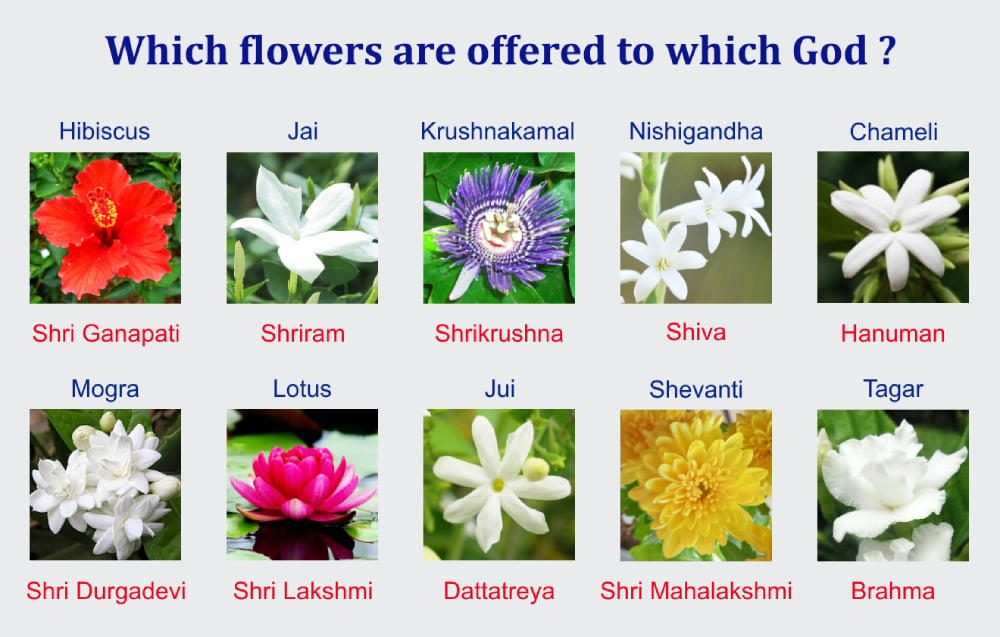
An Exploration Of Hinduism’s Beloved Divine Flowers
- Lord Shiva : Any white Flower. Maulshri, Blue Lotus, and Kaner. Other Flowers like Bel Leaves, Dhatura Flowers , Naagkeshar, Harsingar, Aak are also his favourites. But during Shiva Pooja, you can’t miss having Bilvapatra. But the Chakra and the Bajra should not be present in the Bilvapatra. (Chakras are white marks made by insects while Bajra is the thick portion). If they are present, you need to take them off.
- Lord Ganesha : Any Red Flower. Jaswanti (Hibiscus) is his favourite. Lotus, Champa, Rose, Jasmine, Marigold, Dhruva Grass Blades, Bilva Leaves, Herbal Leaves can also be used to worship him. During Ganesha Pooja, it is advised to use 21 different varieties of Flowers .
- Goddess Parvati : All Flowers that can be offered to Lord Shiva. You can also use white lotus, Bela, Palash, Madar, Apamarg, Champa, and Chameli.
- Goddess Durga : All Red Flowers . Lotus, Mogra Flower and Bel Leaves can also be offered.
- Lord Vishnu : Lotus is his favourite. Other Flowers like Pink Lotus lotus, Maulshri, Juhi, Kadamb, Kewra, Chameli, Champa, Ashok, Malti, Basanti can be used.
- Goddess Lakshmi : Lotus is her favourite. Yellow Gaindha, Desi Gulab, Pink Lotus can be used.
- Lord Rama : Chameli Flower, 4 in number.
- Dattatreya : Jasmine, Bilva Leaves, Audumbar Leaves.
- Lord Hanuman : Chameli Flower, Garland made of Tulsi.
- Lord Brahma : Tagar and White Lotus.
- Goddess Mahakali : Yellow Kaner.
- Goddess Saraswati : White Flower, White Lotus, Palash.
- Lord Surya : Lotus Flower.
- Saturn (Shani) : Blue colored Flowered.
- Lord Krishna : Tulshi Leaves, Blue Lotus, Parijatha, Nandiyavattai, Krishna Kamal This plant has religious importance to it as well due to its analogy with Mahabharat. As the five Yellow Petals are said to be the Pandavas surrounded by 100 blue filaments (Kauravas). The yellow-green stamens are supposed to be Sudarshan Chakra that belonged to Krishna Ji. And due to this analogy, it got its name.
Some Flowers are NOT offer HinduGods and Goddesses?
- Lord Shiva : Champa, Ketaki, Kewda. They were Cursed by Lord Shiva.
- Goddess Parvati : Arka, Amla
- Lord Ganesha : Ketaki Flower, Tulshi
- LordVishnu : Aksada
- Lord Rama : Arali
- Lord Surya : Vilva
- Lord Bhairaav : Nandyarvattam
Flowers hold a special meaning in Hinduism as they represent purity, devotion, and good fortune. They are deeply connected to the Gods and Goddesses worshipped in Hinduism. To enhance your spiritual experience during worship, it is important to know the favourite Flowers of different deities. These floral offerings not only please the Gods but also aid you in your spiritual journey. By incorporating the correct Flowers into your worship, you will witness Divine blessings and grace flowing into your life, as the fragrance of freshly picked blossoms fills the air with tranquility and devotion.
Reference
- About Flowers Used in HinduRituals and Pajas.
- Dr. Dokras Uday, Ancient HinduFlowers , Published On 2020, pp : 1-20, Photos Collected.
- Flowers in the Bhagavad Gita and Their Symbolism for Hinduism, 23rd August 2023.
- Flowers of the Vedas: 10 Divine Blooms in the Ancient Sacred Words of Hinduism, 26th July 2023.
- Kirti, 6 Common Flowers Associated with HinduFestivals, 18th November 2022.
- Lidova Natalia, Drama and Ritual of Early Hinduism, Motilal Banarsidass, First Edition 1994, pp. 96–98.
- List Of Favourite Flowers HinduGods | Pooja Flowers Names Flowers For God.
- Sacred Blooms: Discover the 10 Favorite Flowers of HinduGods.
- Varma Gunjan, Divine Flowers Loved by Hindu, 26th August 2021.
- Why is a specific Flower offered to a deity?. Photos Collected.
- May 15, 2024
- 6 Min Read






